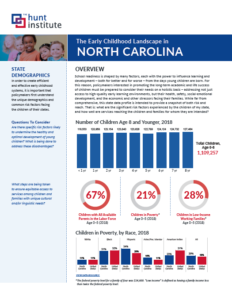The Hunt Institute Releases Updated Early Childhood Landscape Narratives
January 27, 2020
As policymakers and education advocates look to build and strengthen early childhood systems in their states, there are many questions they must consider: What programs are currently provided by my state? How many families benefit — and how many need access but aren’t being served? How much is child care in my state?
 While answers to these questions may exist in diverse resources and throughout various organizations, The Hunt Institute is excited to share its 2020 Early Childhood Data Narratives for all 50 states and Washington, D.C., centralizing existing data from a number of resources into one source.
While answers to these questions may exist in diverse resources and throughout various organizations, The Hunt Institute is excited to share its 2020 Early Childhood Data Narratives for all 50 states and Washington, D.C., centralizing existing data from a number of resources into one source.
New in this year’s data narratives is a summary of price and affordability of infant care as well as federal expenditures on infants and toddlers, including the number of children served by the Child Care and Development Fund and by Early Head Start. Not routinely reported in isolation from larger federal program totals, this data was calculated by The Hunt Institute using other publicly available data in collaboration and consultation with Louise Stoney of the Alliance for Early Childhood Finance.
Updated from 2018, this year’s Early Childhood Data Narratives include data reflecting:
- Poverty and demographic risks
- Birth outcomes
- Developmental screening rates
- Paid family leave status
- Home visiting access
- Affordability of child care
- Access to prekindergarten and much more
Click on your state below to view the 2020 Early Childhood Data Narrative.
Other Resources:


